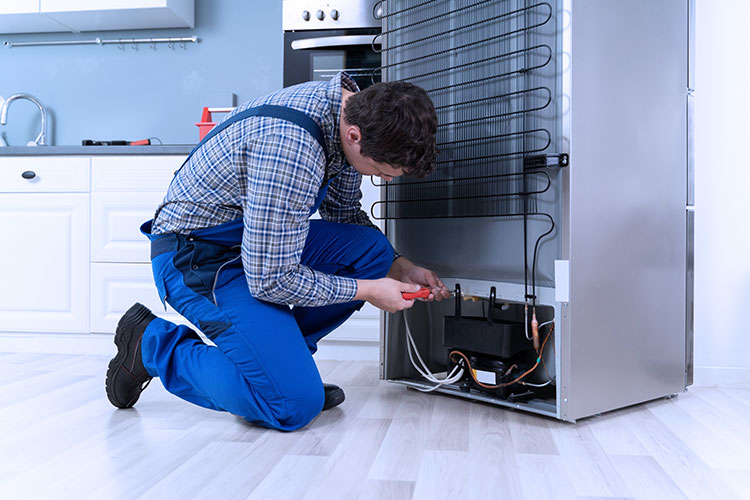Why Avoiding Minor Fixes to Your Freezer Could Wreck Your Budget—Contact Dependable Refrigeration & Appliance Repair Service SubZero Repair
Why Avoiding Minor Fixes to Your Freezer Could Wreck Your Budget—Contact Dependable Refrigeration & Appliance Repair Service SubZero Repair
Blog Article
The Ultimate Guide to Do It Yourself Appliance Fixing Methods
From refrigerators to dish washers, recognizing exactly how to repair and repair these tools can save you time and money. Are you prepared to find crucial strategies that will encourage you to take care of repairs confidently?
Understanding Usual Device Troubles
When you rely upon your home devices, it can be discouraging when they suddenly stop functioning or break down. Recognizing typical device issues can assist you fix problems efficiently. For instance, if your refrigerator isn't cooling, check the temperature level setups or evaluate the door seal for gaps. A malfunctioning cleaning device may be because of a blocked drain filter or a busted belt.
If your oven isn't home heating, defective elements or thermostat concerns might be responsible. Dishwashers usually experience troubles with drainage, so see to it the filter is clean and the drainpipe hose pipe isn't kinked.
Additionally, listen for uncommon sounds; they commonly indicate mechanical concerns. By recognizing these indicators, you can save time and possibly avoid pricey repairs. A little expertise goes a long means in maintaining your appliances, so stay notified to maintain everything running efficiently.
Important Devices for Do It Yourself Repair Works
Prior to diving right into DIY home appliance fixings, it is very important to collect the right tools to assure the procedure goes smoothly. Start with a great set of screwdrivers, including both flathead and Phillips, as they're vital for opening up most devices. You'll additionally want a pair of pliers for grasping and turning cords or small elements.
Don't neglect a multimeter; it aids you examination electrical components and identify problems properly. A socket set is useful for loosening or tightening bolts, while an utility blade can be helpful for reducing cords or opening up packaging.
Finally, think about having a flashlight handy to brighten dark rooms inside your appliances. With these important tools, you'll be fully equipped to deal with different fixings, conserving both money and time. So, gather your gear and get ready to roll up your sleeves!
Safety First: Safety Measures to Take
Prior to you start any kind of appliance repair service, it's important to prioritize safety and security. Ensure you use individual protective equipment, detach the power resource, and maintain your workspace organized. These simple preventative measures can aid protect against crashes and ensure a smoother repair service process.

Individual Protective Devices
Safety and security gear is an important part of any DIY home appliance repair work job. You must constantly use security goggles to shield your eyes from dirt and debris. A durable pair of handwear covers will protect your hands from dangerous products and sharp edges. Take into consideration using a mask if you're handling chemicals or dirt, guaranteeing you breathe securely while functioning. Steel-toed boots are additionally a clever option, especially when raising hefty appliances. Don't forget to put on lengthy sleeves and pants to safeguard your skin from potential injuries. By prioritizing individual safety devices, you'll significantly decrease the risk of accidents and injuries. Keep in mind, being prepared with the best gear maintains you secure and concentrated on completing your repair efficiently.
Power Resource Disconnection
To guarantee a secure DIY device repair work, disconnecting the source of power is necessary. Before you begin any work, you need to unplug the home appliance or turn off the breaker. This easy action avoids electrical shocks and guarantees that you can concentrate on the repair without bothering with unexpected activation. Constantly confirm that the device is off by checking it with a voltage tester. If you're dealing with larger home appliances, like a washer or clothes dryer, see to it to safeguard the power cord and prevent any kind of call with water. Remember, safety! When you're certain that the power is disconnected, you can with confidence proceed with your repair work, recognizing you have actually taken the necessary safety measures to shield yourself.
Job Location Organization
A well-organized workspace can make all the distinction in your DIY appliance repair project. Begin by clearing your work space of mess to prevent mishaps and interruptions. Outline all your devices and products, grouping comparable things together for easy access. Use a toolbox or coordinator to keep little components like screws and washing machines had and labeled. Make certain you've got appropriate illumination; it'll help you see details plainly and lower the danger of mistakes. Don't neglect to keep security equipment like handwear covers and safety glasses available. Ultimately, have a garbage bag helpful to take care of waste promptly. A tidy room not just improves performance however likewise maintains you risk-free while you deal with your appliance repair work.
Step-by-Step Overview for Refrigerator Fixes
When your fridge starts acting up, it can be aggravating, yet taking on the trouble yourself can save you time and money. Examine for common problems like temperature level fluctuations or uncommon sounds. For a noisy refrigerator, check the fan and validate it's not obstructed.
If there's water merging within, evaluate the door seals for damages or dust, and clean them if needed. For ice build-up, clear the defrost drainpipe. As soon as you've addressed the problem, connect the fridge back in and monitor it for a couple of hours. If the trouble lingers, you may require to replace a faulty part, like the compressor or fan motor. Keep in mind, do not wait to consult the manual or seek specialist assistance if needed.
Repairing Cleaning Equipment Concerns
Just like refrigerators, washing makers can provide their very own collection of difficulties, however lots of problems can be solved with a little bit of troubleshooting. If your equipment will not begin, examine the power cord and verify it's plugged in.
Tightening up these can frequently resolve the problem. Normal upkeep, like cleansing the filter, can stop many problems from developing.
Fixing Ranges and stoves
Exactly how can you article fix usual problems with your oven or stove? Beginning by inspecting the power supply.
If your oven isn't heating, examine the temperature settings and validate the door seals firmly. If it's harmed., a malfunctioning heating element could additionally be the perpetrator; you may require to replace it.
For uneven food preparation, turn your pans and take into consideration using a great site stove thermometer to validate exact temperatures. Finally, if you listen to uncommon noises or smell gas, shut off the device immediately and speak with a specialist. By following these steps, you can determine and resolve many usual stove and stove concerns effectively.
Repairing Dishwashers Facilitated
When your dish washer starts breaking down, it can be frustrating, however resolving usual problems isn't as hard as it seems. You'll learn step-by-step troubleshooting techniques that will help you pinpoint the problem, together with the necessary devices you'll need to deal with repair services on your own. Let's make fixing your dishwasher a breeze!
Usual Dish Washer Concerns
While dish washers are made to make your life easier, they can sometimes encounter usual concerns that leave you feeling annoyed. One frequent problem is poor cleansing efficiency; this typically takes place as a result of stopped up spray arms or dirty filters. You might additionally observe water pooling near the bottom, which can show a faulty drainpipe or a kinked hose pipe. If your dishwashing machine's door won't lock, maybe a basic issue with the lock mechanism or door seal. Additionally, unusual sounds can indicate loose components or worn-out parts. If you smell something odd, it could be time to inspect for food debris or a malfunctioning electric motor. Resolving these issues early can save you time and problem in the future Continue (Best Sub-Zero repair Service Dependable Refrigeration & Appliance Repair Service).

Detailed Troubleshooting
Before diving into repair work, it's vital to recognize the details concern your dish washer is encountering. If your dish washer will not start, inspect the power supply and door latch. By methodically dealing with each potential issue, you can determine the trouble and take the essential actions to fix it, making your dishwashing machine function like brand-new once again.
Important Repair Service Tools
Having the right devices at your disposal can make all the difference when fixing your dishwashing machine. Don't neglect a container or towels for any water splashes during repair services.
If you're dealing with clogs, a drainpipe snake or a wet/dry vacuum will be very useful. You may additionally want a degree to ensure your dish washer's appropriately aligned. Lastly, safety equipment like handwear covers and safety glasses will protect you while you work. With these essential tools, you'll be well-equipped to take on any kind of dishwasher repair service challenge that comes your method.
Frequently Asked Inquiries
How Do I Figure out if a Device Is Worth Repairing?
To determine if a home appliance's worth fixing, consider its age, fixing costs, and current value. You might want to invest in a new model instead - Dependable Appliance For SubZero Freezer Repair. if fixings surpass half the replacement cost.
Can I Find Substitute Components Locally for My Home Appliance?
Yes, you can usually discover replacement parts in your area for your home appliance. Inspect hardware shops, home appliance service center, or neighborhood classifieds. Do not forget to bring the model number to assure you get the correct component!
What Usual Mistakes Should I Prevent When Repairing Devices?
When fixing appliances, stay clear of hurrying through diagnostics, overlooking security precautions, or making use of inaccurate devices. Don't miss checking out manuals or enjoying tutorials; they offer essential advice. Hold your horses and comprehensive to assure successful fixings and avoid more damage.
The length of time Does a Regular DIY Home Appliance Repair Take?
A regular DIY home appliance repair normally takes one to 3 hours, depending upon the intricacy. You'll wish to gather your devices and materials first, and comply with guidelines thoroughly to stay clear of unneeded delays.
Are There Any Kind Of Warranties for DIY Device Repairs?
When you deal with do it yourself device repair work, guarantees typically don't cover your work. Some makers could recognize service warranties for components you replace. Always inspect your home appliance's service warranty terms prior to beginning any kind of repairs to avoid problems.
Before diving into DIY home appliance repair services, it's vital to collect the right devices to assure the procedure goes efficiently.Prior to you begin any kind of device repair, it's essential to prioritize safety.To guarantee a safe DIY appliance repair work, disconnecting the power source is important.A well-organized work location can make all the distinction in your Do it yourself device fixing task. Constantly inspect your appliance's warranty terms before beginning any repair services to prevent problems.
Report this page